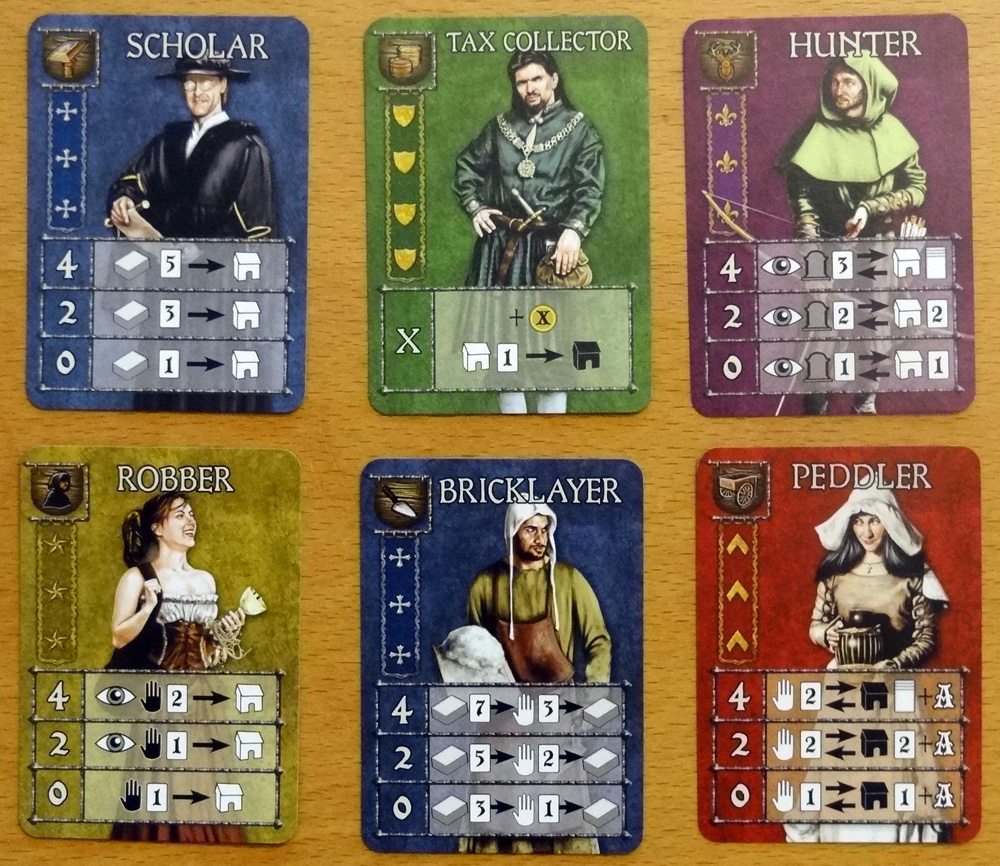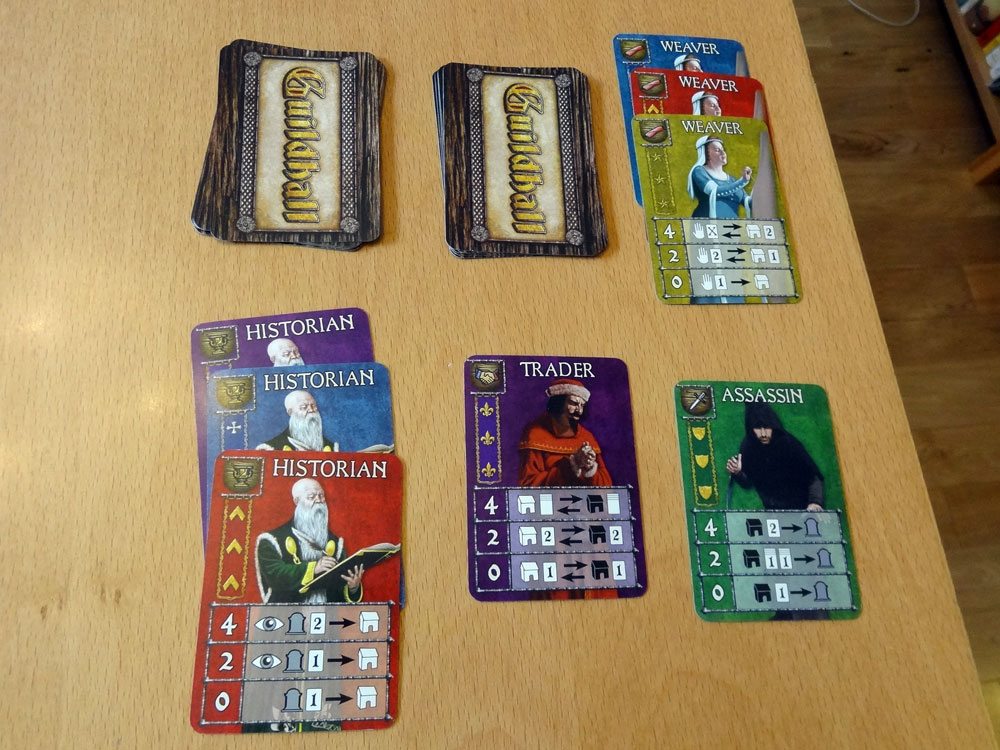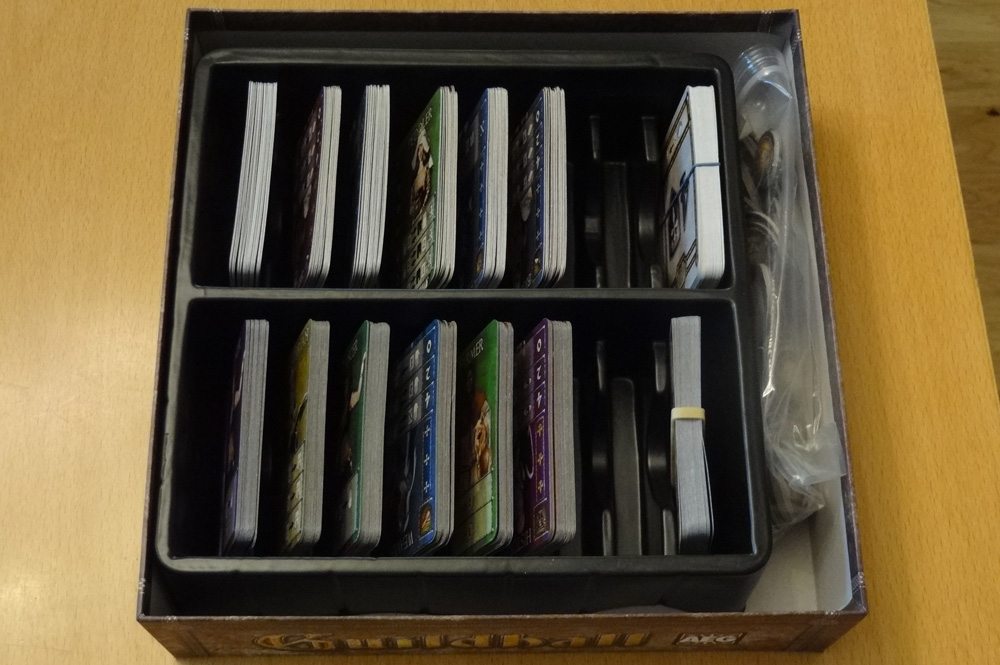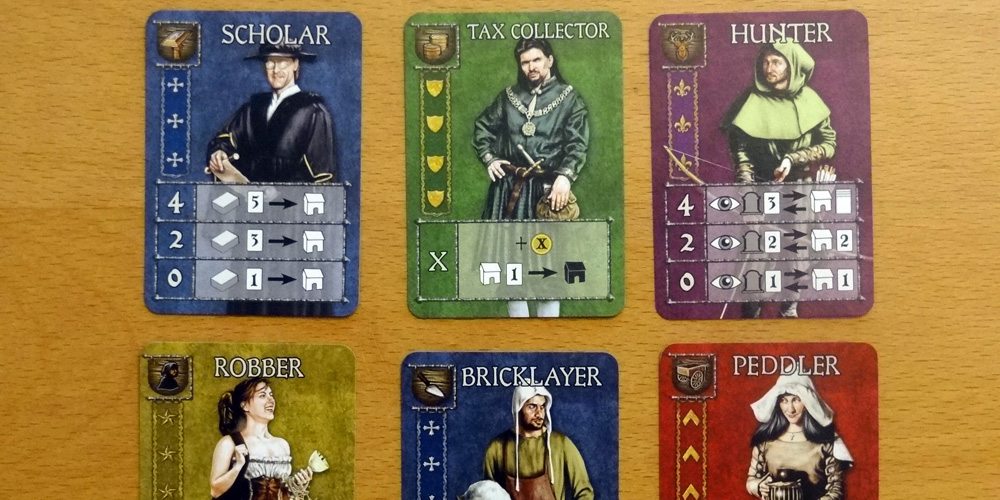
Ah, job fairs—those wonderful places set up for you to trudge around and hand out your resumes to companies you don’t really want to work for (or, conversely, companies who really don’t want to hire you). Thankfully, Guildhall: Job Faire is nothing like that. (For one thing, the list of available professions includes “robber,” so you know this isn’t your typical meet-n-greet.) Job Faire is a stand-alone expansion to AEG’s Guildhall: Old World Economy, with six new types of workers that can either be played on their own or mixed in with the original game. Like the original, Job Faire is an engaging and quick card game that offers more depth than you might expect.
Players: 2 to 4
Ages: 12 and up
Playing Time: 30 minutes
Retail: $29.95

Components:
Job Faire (just like the original) comes with:
- 120 Profession cards (4 sets each of 6 professions in 5 colors)
- 30 Victory Point (VP) cards
- 52 Victory Point (VP) tokens
The tokens are cardboard punch-outs; nothing special but pretty sturdy, although there was a tendency for the paper to tear in some areas. The card quality is typical of other AEG titles—pretty nice, easy to shuffle (although it’s a pretty big stack).
The victory point cards are actually the same as the originals, so AEG could have released just the profession cards as an expansion, but this gives you more flexibility—you can just get one or the other, and if you have both, you could have two games going concurrently.
You generally don’t need that many VP tokens, and if you have both games, you’ll have WAY more than you need. My only real complaint about the game is the box, but I’ll save that rant for later.

Gameplay:
The full rulebook is available here as a PDF. The gameplay in Job Faire is exactly the same as Old World Economy, just with different professions. (If you want to combine games, you actually just select six professions total, rather than shuffling everything together.)
To set up the game, you shuffle together the huge stack of profession cards, and deal 9 to each player. Then you shuffle the pile of VP cards separately, lay out five in the center of the table, and put the rest in a stack face-down. Each player may discard any number of cards, then draws back up to a hand of 9 cards, and finally chooses three cards to play into their guildhall (face up on the table).
You get two actions each turn, choosing from the following:
- Play 1 card and resolve its action.
- Discard any number of cards and draw back up to 6.
- Buy 1 VP card from the center.
You may use any combination of actions: play 2 cards, play 1 card and buy 1 VP card, discard/draw and then play 1 card, etc.
Play 1 card: You may only play a card if it does not have an exact match already in your guildhall. For instance, if you have a yellow Robber already in the guildhall, you may not play another yellow Robber. You also may only play one card of a profession during your turn, so you may not play a purple Bricklayer and a red Bricklayer in one turn.
When you play a card, you will get a bonus effect based on the number of cards of that profession already in your guildhall. Here’s a brief summary of what the six professions do (specific details are in the rulebook):
- Bricklayer: draw, then put cards back on the deck
- Hunter: swap cards between discard pile and your guildhall
- Peddler: swap cards between your hand and another player’s guildhall, plus get another action
- Robber: put cards from another player’s hand into your guildhall
- Scholar: put cards from the deck into your guildhall
- Tax Collector: get VP by putting cards into another player’s guildhall

Just for comparison, here are the six professions from Old World Economy as well:
- Assassin: discard cards from another player’s guildhall
- Weaver: exchange cards between your hand and your guildhall
- Dancer: draw cards and get an extra action
- Trader: trade cards between your guildhall and another player’s
- Historian: place cards from the discard pile into your guildhall
- Farmer: earn VP tokens.
The more of a profession you already have in your guildhall, the stronger the effect. For instance, if you no Robbers yet, then playing a Robber will let you draw a card at random from another player’s hand and put it into your guildhall. But if you have at least two Robbers already, playing an additional Robber lets you look at their hand and choose a card to steal. Finally, if you have four Robbers, then playing the fifth Robber will let you pick two from the player’s hand.
Once you have one of each color of a particular profession, then those five cards are flipped over, forming a completed “chapter.” Chapters are no longer affected by any cards played and are safe from attacks. But you may only have 3 completed chapters at a time; any more that are completed are discarded.
Discard and draw: Just like it says. Throw away any number of cards (including none) and draw back up to 6. Note that there is no default “draw cards” action so you only get more cards through card effects and by taking this action.
Buy 1 VP card: The VP cards can be purchased by discarding completed chapters from your guildhall, and they cost either 1 or 2 chapters (as indicated by the icons at the top). The VP cards are worth varying numbers of points, and some of them also have an additional one-time effect when you purchase them, such as additional actions, stealing cards from another player’s guildhall, and so on. When you purchase a VP card, it is replaced by one from the deck.
If, at the end of your turn, you have 20 points or more, then you win the game.

Conclusion:
I wasn’t sure what to expect of Guildhall the first time I played it—I wasn’t really impressed with what seemed to be a very simple game. It has a little of the flavor of Dominion even though it’s not a deck-builder at all, because of the setting and the way that it’s all about card effects and how to best combine them. One of the most interesting aspects is the way that one profession gets more and more powerful as you add cards to it, but then there are fewer and fewer cards you can play of that profession. If you have four Hunters, then there is only one other color of Hunter that you can play—but that last Hunter becomes more powerful. And once you’ve completed a chapter and flipped it over, then you can play more cards of that profession again, but their bonus effects have been reset to the lowest value again. That also means that sometimes you can purposely get rid of cards in your own guildhall (trading them to another player, for instance) in order to play that same card from your hand again to get the bonus effect.
Job Faire seemed to have more professions that affect other players: the Bricklayer lets you stack the deck; the Tax Collector benefits other players even while you’re collecting points; a few of the others take cards from your opponents’ hands or guildhalls. The original game had some “take that” gameplay (particularly with the Assassin) but Job Faire really increases the direct interaction. Of course, that means I’d recommend it mostly for players who aren’t going to take things personally, because there’s no good way to play this game with people who want to be nice to each other.
The victory point cards in Job Faire are exactly the same as the original, but in case you haven’t played that one then this is worth mentioning: there are even interesting decisions to be made in buying the VP cards, because of the bonus effects on them. Sometimes it’s worth buying a lower-point card because you may get a more powerful effect. Also, you don’t want to hang onto completed chapters for too long, because you can only keep three at a time anyway.
With only 20 points required for victory and the possibility of a 9-point card, you rarely feel like you’re out of the running. Even if somebody gets up to 19 points and you’re trailing, there’s a possibility of catching up and taking the win. At most, you’ll have somebody complete a chapter, meaning that they can win on their next turn unless you can score first: which means that the longest you’ll have to continue playing once victory is inevitable is a single round.
There is, of course, a good amount of luck involved in drawing the cards you need and having the right VP cards when you want to cash in, but I think the game also allows room for strategy and making the most of the cards you draw. Guildhall and Job Faire aren’t heavyweight strategy games or deeply thematic; however, if you’re looking for a quick card game that encourages player interaction, they are both an excellent choice.

Rant
Ok, so here’s my rant. It really doesn’t have anything to do with the gameplay, but I’m tired of large boxes and weird plastic inserts that don’t really make sense. The original game came in a box that was much bigger than necessary—but the plastic insert was sized to hold exactly the number of cards in the game, so there wasn’t even room for expansion.
I figured the expansion would get that right—provide a proper divider so you could store both games in it. Well, when I compared boxes, the first thing I noticed was that Job Faire‘s box is even bigger. And although the rulebook specifically references keeping both games in the box, it says “just keep each profession in its own slot.” Hmm, I count five slots in the Job Faire insert, and 12 professions between the two games. The larger box also came with a larger rulebook, so you can’t even combine both games in the smaller of the two boxes unless you want to fold up the rulebook somehow.
Then I remembered that Smash Up had a divider with a lot of slots—maybe I could steal that (since I was using the Awesome Level 9000 box for that game)! However, despite the fact that they’re both AEG games, the Smash Up box is a teeny bit bigger (we’re talking millimeters) than the original Guildhall box, just big enough that if you shove the insert into the Guildhall box then the lid doesn’t fit anymore. Not that it matters, since the aforementioned rulebook is much bigger anyway.

I finally settled on putting the Smash Up divider into the Job Faire box—there’s extra space all around, but that’s enough for the huge pile of VP tokens. There are enough slots that I can keep each stack of VP cards separate, plus the twelve different professions (if I actually wanted to sort them all out). It’ll work—until another expansion comes out, at which point I really hope AEG uses a box that makes more sense.
Disclosure: GeekDad received a review copy of this game.




